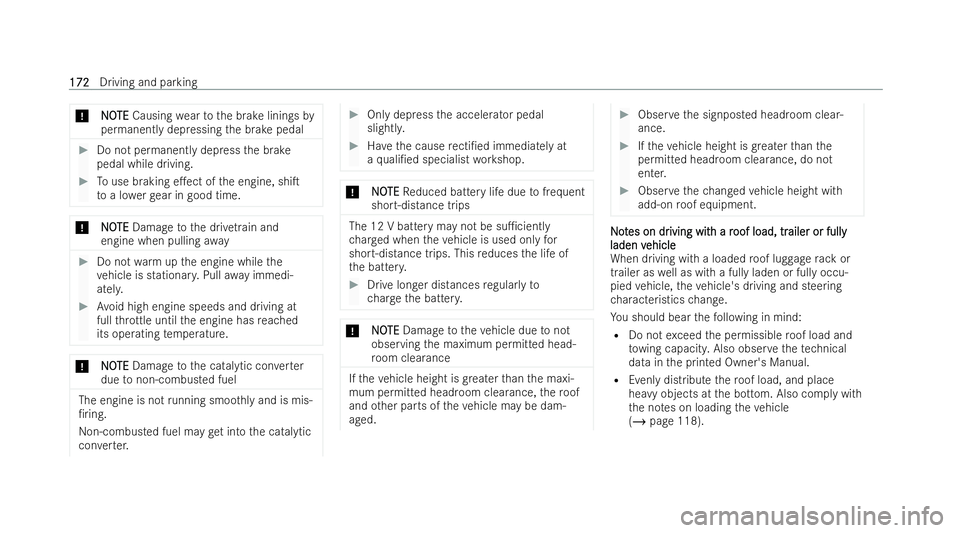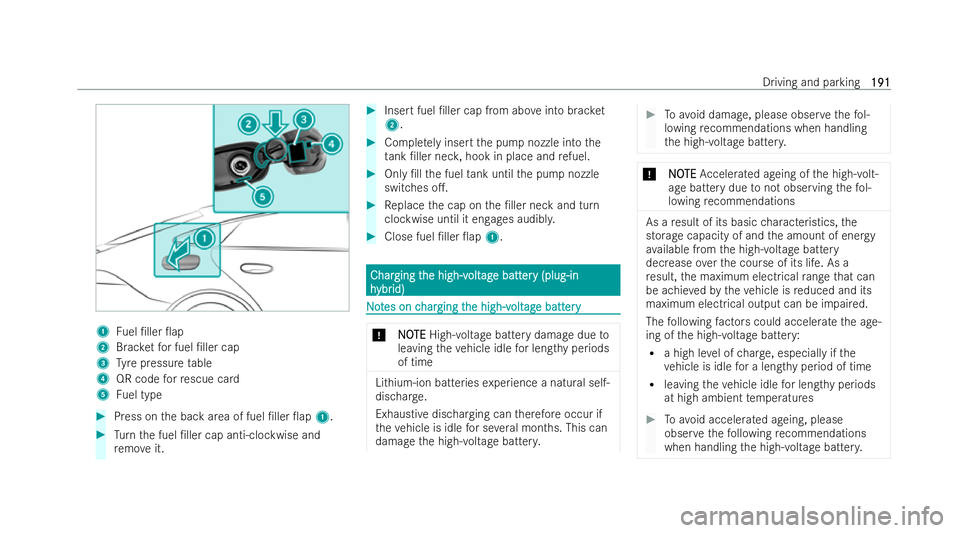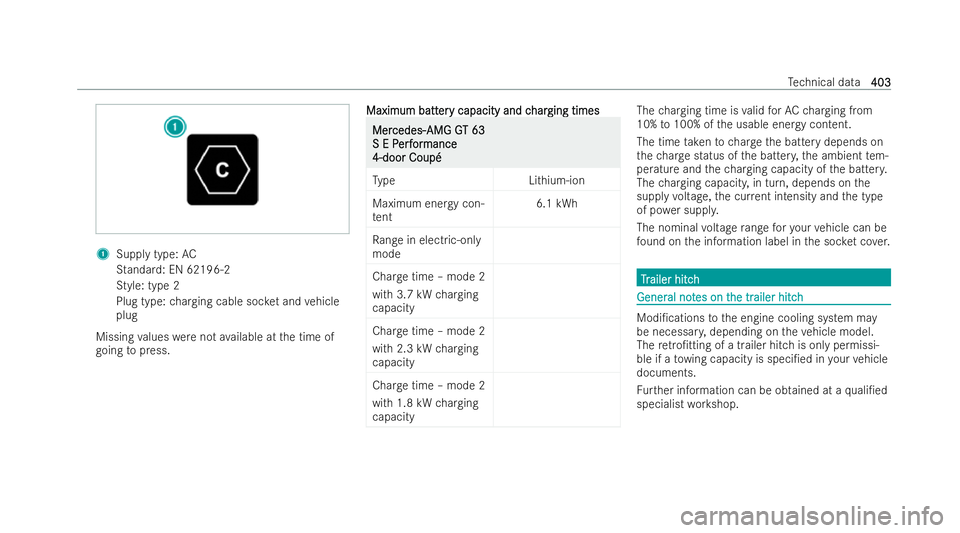Page 175 of 533

*
N
NO
OTE
TE Causing wearto the brake linings by
permanently depressing the brake pedal #
Do not permanently depress the brake
pedal while driving. #
Touse braking e�.ect of the engine, shi�T
to a lo werge ar in good time. *
N
NOOTE
TE Damage tothe driv etra in and
engine when pulling away#
Do not warm upthe engine while the
ve hicle is stationar y.Pull away immedi-
atel y. #
Avoid high engine speeds and driving at
full thro ttle until the engine has reached
its operating temp erature. *
N
NOOTE
TE Damage tothe catalytic con verter
due tonon-combusted fuel The engine is not
running smoo thly and is mis-
�/ring.
Non-combus ted fuel may getinto the catalytic
con verter. #
Only depress the accelerator pedal
slightl y. #
Have the cause recti�/ed immediately at
a qu ali�/ed specialist workshop. *
N NOOTE
TE Reduced battery life due tofrequent
short-distance trips The 12 V battery may not be su�1cien
tly
ch arge d when theve hicle is used only for
short-dis tance trips. This reduces the life of
th e batter y. #
Drive longer distances regula rly to
ch arge the batter y. *
N
NO
OTE
TE Damage totheve hicle due tonot
observing the maximum permitted head-
ro om clearance If
th eve hicle height is greater than the maxi-
mum permitted headroom clearance, thero of
and other parts of theve hicle may be dam-
aged. #
Obser vethe signposted headroom clear-
ance. #
Ifth eve hicle height is greater than the
permitted headroom clearance, do not
enter. #
Obser vethech anged vehicle height with
add-on roof equipment. N No
ot
tes on dr
es on dr iving wit
iving with a r
h a roof load, tr
oof load, tr ailer or fully
ailer or fully
laden v
laden v ehicle
ehicle
When driving with a loaded roof luggage rack or
trailer as well as with a fully laden or fully occu-
pied vehicle, theve hicle's driving and steering
ch aracteristics change.
Yo u should bear thefo llowing in mind:
R Do not exceed the permissible roof load and
to wing capacity. Also obser vethete ch nical
data in the printed Owner's Manual.
R Evenly distribute thero of load, and place
heavy objects at the bottom. Also comply with
th e no tes on loading theve hicle
(/ page 118). 172
172
Driving and parking
Page 194 of 533

1
Fuel �/ller �0ap
2 Brac ketfo r fuel �/ller cap
3 Tyre pressure table
4 QR code forre scue card
5 Fuel type #
Press on the back area of fuel �/ller �0ap 1.#
Turn the fuel �/ller cap anti-clockwise and
re mo veit. #
Insert fuel �/ller cap from abo veinto brac ket
2 . #
Comple tely insert the pump nozzle into the
ta nk �/ller nec k,hook in place and refuel. #
Only �/ll the fuel tank until the pump nozzle
switches o�.. #
Replace the cap on the �/ller neck and turn
clockwise until it engages audibl y. #
Close fuel �/ller �0ap 1. Char
Char
ging t
ging t he high-v
he high-v olt
oltag
age batt
e batt er
ery (plug-in
y (plug-in
h
h ybr
ybr id)
id) N
No
ot
tes on c
es on c har
harging t
ging t he high-v
he high-v olt
oltag
age batt
e batt ery
ery *
N
NOOTE
TE High-voltage battery damage due to
leaving theve hicle idle for lengt hyperiods
of time Lithium-ion batteries
experience a natural self-
dischar ge.
Exhausti vedischarging can therefore occur if
th eve hicle is idle for se veral months. This can
damage the high-voltage batter y. #
Toavo id damage, please obser vethefo l-
lowing recommendations when handling
th e high-voltage batter y. *
N
NO
OTE
TE Accelerated ageing of the high-volt-
age battery due tonot observing thefo l-
lowing recommendations As a
result of its basic characteristics, the
storage capacity of and the amount of energy
av ailable from the high-voltage battery
decrease over the course of its life. As a
re sult, the maximum electrical range that can
be achie vedby theve hicle is reduced and its
maximum electrical output can be impaired.
The following factors could accelerate the age-
ing of the high-voltage batter y:
R a high le vel of charge , especially if the
ve hicle is idle for a lengt hyperiod of time
R leaving theve hicle idle for lengt hyperiods
at high ambient temp eratures #
Toavo id accelerated ageing, please
obser vethefo llowing recommendations
when handling the high-voltage batter y. Driving and parking
191
191
Page 406 of 533

1
Supply type: AC
St andard: EN 62196-2
St yle: type 2
Plug type: charging cable soc ket and vehicle
plug
Missing values werenot available at the time of
going topress. Maximum batt
Maximum batt er
ery capacity and c
y capacity and c har
harging times
ging times Mer
Mer
cedes-
cedes- AMG G
AMG G T 63
T 63
S E P
S E P erf
erfor
ormance
mance
4‑door Coupé
4‑door Coupé
Ty pe Lithium-ion
Maximum energy con-
te nt 6.1 kWh
Ra nge in electric-only
mode
Cha rge time – mode 2
with 3.7 kW charging
capacity
Char getime – mode 2
with 2.3 kW charging
capacity
Char getime – mode 2
with 1.8 kW charging
capacity The
charging time is valid forAC charging from
10% to100% of the usable energy content.
The time take nto charge the battery depends on
th ech arge status of the batter y,the ambient tem-
perature and thech arging capacity of the batter y.
The charging capacit y,in turn, depends on the
supply voltage, the cur rent intensity and the type
of po wer suppl y.
The nominal voltage range foryo ur vehicle can be
fo und on the information label in the soc ket co ver. T T
r
railer hitch
ailer hitch Gener
Gener
al not
al notes on t
es on t he tr
he trailer hitch
ailer hitch Modi�/cations
tothe engine cooling system may
be necessar y,depending on theve hicle model.
The retro�/tting of a trailer hitch is on lypermissi-
ble if a towing capacity is speci�/ed in your vehicle
documents.
Fu rther information can be obtained at a quali�/ed
specialist workshop. Te
ch nical data
403 403